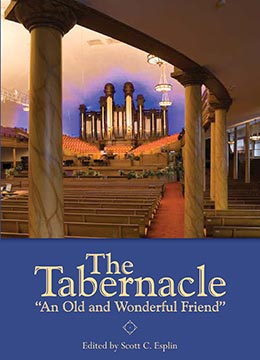The Organ
Scott C. Esplin, “The Organ,” in The Tabernacle: “An Old and Wonderful Friend” (Provo, UT: Religious Studies Center, Brigham Young University, 2007), 201–15
A major source of the fame of the Mormon Tabernacle is its organ and choir. The regular Sunday broadcasts combined with the trips made by the choir have spread the fame of the Tabernacle around the world. The story of the Mormon Tabernacle Choir is separate from the building of the Tabernacle, but the great organ is such an integral part of the building itself and so intertwined in its history as to merit its own chapter.
The organ, like the Tabernacle itself, had a predecessor. Its history is best told by a review of the life of Mr. Joseph H. Ridges, the builder of both the Tabernacle organ and its predecessor. The summary of his life and works, which appeared in the Deseret Evening News, March 9, 1914, at the time of Mr. Ridges’s death, provides background:
Joseph H. Ridges was born April 27, 1826, at Ealing, a suburb of Southampton, England. From his earliest boyhood he was interested in organ construction, and when only a few years old he spent many days watching the operations of workmen in an organ loft and factory across the street from his boyhood home. He formed an intimate friendship with a boy employee, from whom he learned much about the intricacies of organs and the two often visited the organ loft together, one would blow while the other played on the collection of old organs of varied size and power.
Mr. Ridges later spoke of himself as a “human sponge,” absorbing practically everything he could learn about organs and their making. As he grew older he took long walks to search out experts, from whom he could add to his information, or to see and play upon some instrument in the churches of nearby cities. He often attended church services to hear the instruments played and not infrequently allowed himself to be locked in the chapel until the evening service, inspecting, studying and dreaming about the organ pipes, tones, bellows, valves, etc.
At the age of 23 he was led by an adventurous spirit into Australia with the gold seekers. Five long months were passed on the sea before he and the little party landed at Sydney. In the mining localities he worked at the trade of carpenter and cabinet maker. . . . It was at Sydney, after spending some time in the camps, that he first undertook to build an organ. Being unable to get experienced workmen to assist him, and having to earn his own living, he worked at the organ at night until it was completed. It was the first church organ in Australia, and attracted much attention. Among those to see the organ was a “Mormon” elder, then presiding in Australia, who asked the builder to donate it to the “Mormon” Church. Having previously been converted to this faith, Mr. Ridges consented, and they soldered the various sections of the instrument up in large tin cases and shipped them across the Pacific to San Pedro. When they arrived there, accompanied by the builder, they were met by teams sent by Charles C. Rich and Amasa Lyman from San Bernardino, and the organ was brought to [Salt Lake City] and set up in the old adobe tabernacle.[1]
The predecessor to the great organ of the Tabernacle was, therefore, recruited by the missionary activity of the Church and was brought the great distance from Australia by boat and by wagon from California to Salt Lake City. This organ was installed in the Old Tabernacle and was played “for the first time at regular services on October 11, 1857.”[2] And from that time until the Old Tabernacle was torn down, the organ served its purpose well.
At the time of the construction of the large Tabernacle, the question arose as to what type of organ it would have. The incident is recorded as follows: “When the new tabernacle was constructed, the question arose concerning a big organ for it. President Brigham Young asked Mr. Ridges if he believed it would be possible to make an organ in this valley similar to the one he had made in Australia and brought here. He said he thought it could be done and President Young asked him to draw preliminary plans. The plans were drawn, submitted and accepted, and the work began.”[3]
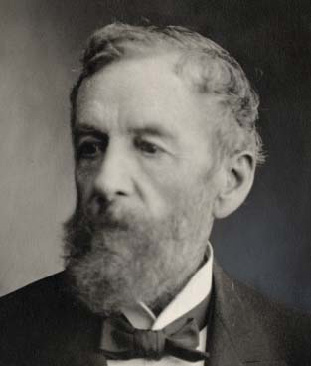 Joseph H. Ridges, creator the Tabernacle organ
Joseph H. Ridges, creator the Tabernacle organ
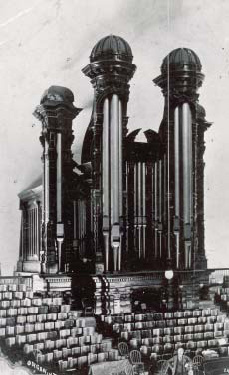 Joseph H. Ridges built the original organ for the newly constructed Great Tabernacle during 1866 and 1867
Joseph H. Ridges built the original organ for the newly constructed Great Tabernacle during 1866 and 1867
The first task was to locate suitable wood for organ construction. As Levi Edgar Young explained, Mormon colonists throughout the intermountain region were requested to forward specimens of wood from over the entire area. These specimens were studied, and “it was finally decided that the best wood was found in the hills around Parowan and in Pine Valley,” near St. George in southern Utah. This wood was especially desirable for the large pipes of the organ because it was straight grained and free from knots.[4] The transportation of the lumber for the organ over the 350 miles of poor road from Pine Valley to Salt Lake City was done by ox team. The troubles in such transportation have been told by Levi Edgar Young:
Over the long, lonely roads trudged the oxen day by day, hauling the heavy logs to Salt Lake City. At times there were as many as twenty large wagons, each with three yoke of oxen drawing its load. The roads were rough and dusty, and many streams had to be bridged, that the wagons could pass over without difficulty. In crossing one stream in southern Utah the logs were let down over the bank with ropes and the oxen driven some miles to find a ford, where they crossed and followed on down the bank to pick up the wagons and loads again. The timber was finally landed in Salt Lake City.[5]
The work on the organ was begun in January of 1866, but much of the work at that time was preliminary. In addition to finding the right type of wood, experimental work was also necessary to find a method of manufacturing a suitable type of glue. Many of the parts of the instrument were not available in the remote area of Salt Lake City, so Mr. Ridges made a trip to Boston to secure them. There he procured spring wire, thin sheet brass, soft fluff leather for the valves, ivory for the keys, and other items not available or not able to be manufactured in Utah. These were brought into Utah by ox teams from the nearest railroad.[6] The difficulties in building the organ are well described in an article in Goodwin’s Weekly: “The story of the building of the original Tabernacle organ is an epic of the West. In perhaps no other country could such mountains of difficulty and obstacle have piled one upon another like Pelion upon Ossia, to harass and thwart so noble an ambition as that of Joseph Ridges. The old organ made of home-made glue, boiled in great pots just outside the Tabernacle: the leather bellows were made of home tanned hides; smooth pine was hauled by wagon from St. George.”[7]
Just before the death of Mr. Ridges, he described the building of the organ as follows: “We built that organ from native lumber, with homemade nails and glue, and raw hide from the pelts of Utah cattle and calves.[8]
Although preliminary work on the organ was started in 1866, the base for the organ was not laid in the Tabernacle until the summer of 1867. Truman O. Angell records the laying of the foundation for the organ: “Tuesday, August 6, 1867. All the fore part of today my attention was on placing the stones to take the timbers under the organ, singers stand, etc.”[9] From the time of the laying of the foundation for the organ the work progressed rapidly, because it was in condition to accompany the choir at the first meeting in the Tabernacle on October 6, 1867. Thus, the organ was installed in its place and was sufficiently tuned to accompany the singing in the short space of two months. This indicates that most of the building of its parts was done at a place other than in its location in the Tabernacle. When it was first used the organ was far from complete. The report of the first meeting in the Tabernacle indicated this:
[President Brigham Young] thought it proper to say something of the unfinished condition of the organ. Not over one-third of the pipes were up, and till the casing was built, they had thrown around it a loose garment. It was now only about fifteen feet high, but when completed it would be forty feet high. Bro. Ridges and those who had labored with him had done the best they could, and notwithstanding their diligence, by early day, noon and night, they had been unable to have it properly tuned. It was, however, in a condition to accompany the choir, and he was pleased with it.[10]
The work of completing the organ continued with the work on the completion of the rest of the Tabernacle. It was not until 1869 that it neared completion. It was described in an article in the Deseret Evening News, July 3, 1869:
The New Organ—On entering the New Tabernacle to-day, we were filled with admiration at the beauty and grandeur of the great organ, now that the scaffolding has been removed, and the organ case grained and varnished. Its cathedral like shape with the immense towers and symmetrical proportions, now stand out beautifully, and the entire work reflects great credit upon Bro. J. Riges the designer and builder. When completed the Organ will compare favorably with any in the world for its beauty of design and purity of tone. Bro. Ridges informs us that a large amount of work has yet to be bestowed upon it and that the octave of immense pipes in front, which are now white, will be covered with gold leaf, and that many other smaller ornamental pipes have to be placed where the green drapery is now arranged, together with some beautifully carved panel work for the pedestal portion of the case. We have heard but one expression about the Organ from the many visitors who have examined the workmanship and listened to its tones: they think it is a remarkable piece of mechanism to be built in this country, and that it is not inferior, so far as completed, to the eastern and foreign made instruments of its class.[11]
On August 21, 1869, John D. T. McAllister wrote a letter to President A. Carrington in which he commented: “We have a great many strangers calling on us, and very often an outside preacher. . . . The new organ begins to look nice. The gallery in the new Tabernacle will start this fall.”[12]
Work upon the organ continued for some time; therefore it is most difficult to assign a definite date as to when it was completed. However, it is most likely that the summer of 1870 would be the best approximation. At the time of its completion, the organ had 2,638 pipes[13] and presented an appearance as shown in the picture of the interior of the Tabernacle on page ___. A newspaper of the time reported on the organ: “It has two manuals . . . twenty-seven pedals, with the pedal compass from four C’s to D. Its compass embraces 35 stops, five of which are mechanical. . . . The largest [pipe], C C C C [will be] thirty-two feet in length. The two manuals are the swell organ and the great organ. . . . The instrument when complete will be 20 by 30 feet, and approximately 40 feet high.[14]
When the organ was first used it was pumped by hand. Five men were required to provide the necessary power. Mr. Samuel S. Bateman, a guide at the Tabernacle Block, showed the author around and under the organ and told an interesting story relative to the manpower required for the organ:
A distinguished guest was being entertained at the Tabernacle, and had been brought to the building expecting a notable recital. The organist was very much “keyed up” because of the dignity and fame of the visitor, and therefore was most anxious to put on an excellent performance. After the necessary preliminaries, the organist sat at the console and prepared to play. However, when he put his hands to the keys no sound emerged. He tried again, and still again, and had no better success. So with a very embarrassed look he disappeared behind the organ to locate the trouble. There he found the five men who were supposed to pump the organ sitting on their chairs and doing nothing. Reprimanding the leader of the group, he asked why they had not been pumping the organ. “Well,” replied the man, “I wanted our dignified guest to know that there was someone else beside you who had something to do with the working of the organ.”
A little later a large waterwheel was put in the basement of the Tabernacle, and that provided the power for the organ. No exact date of this change could be found, but one of the members of the Church historian’s staff recalled the date as being prior to 1875. Several other members of the staff remember seeing the old waterwheel and being in the dark damp room. The water for the wheel was taken out of City Creek where it ran along North Temple Street. After it had served its purpose of spinning the “organ wheel,” the water left the Temple Block at a point about fifteen feet north of the present west gate of the block. Close observation of the wall at the spot indicated will show an archway about three feet high which provided the exit for the water. The archway was bricked in when the organ was provided with electrical power.
In 1900 the organ was almost completely rebuilt, electrified, and brought up to date. The work was done by the Kimball Organ Company.[15] At the time the work was completed, the Tabernacle organ was considered one of the finest in the world, and its fame for size as well as sweetness of tone continued to grow. This remodeling, however, left the outward appearance of the organ the same as it was previously, with the new mechanism being placed inside the old case and in the basement portion of the Tabernacle. The work was completed in June of 1901, and the occasion was celebrated with a concert given by Dr. G. W. Walter, of Washington D.C.[16]
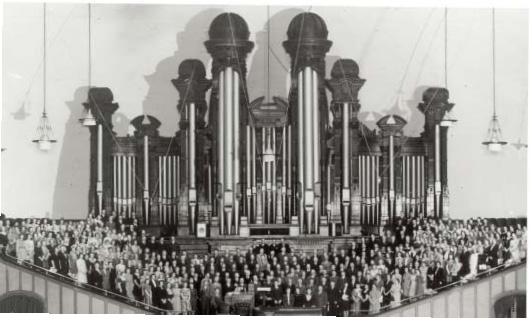
The organ has been remodeled several times. In 1915, the Tabernacle organ was renovated, extending its width from thirty feet to its current width of sixty feet
In 1915 the greatest change was made in the organ. Rapid strides had been made in organ development between 1900 and 1915, and in order to keep the Tabernacle organ among the world’s finest, it was again necessary to have the organ overhauled and expanded. The remodeling project was well described at the time of its completion in Goodwin’s Weekly:
It was about a year ago [1915] that plans were perfected for the construction of the newer, greater organ, which would so far eclipse the old as to leave its sweetness, its majesty and its power, only as a memory. That work is nearly finished now, and the world will again marvel at what these men of the west have accomplished.
The new organ will follow the outlines of the old in its familiar and classic form. The sacrilege of changing the identity of the wonderful visualization of the massive towering instrument has not been committed. That visualization of the massive towering batteries of pipes, is too dear to the mind’s eye of hundreds of thousands, to suffer a change. The exterior of the organ, however, is double the size of the old familiar instrument. This has been done by extending wings to the right and left of the central instrument, which is thirty feet in width. The new wings are each fifteen feet in width, giving the organ a total frontage now of sixty feet.
The central towers of the organ are each thirty-two feet in height. The towers of each of the new wings rise a little more than twenty-four feet above the Tabernacle floor, making a beautiful and symmetrical appearance. The wings are concaved, sweeping outward from the central instrument in graceful arcs.
The new organ will be the most perfect in existence, organ experts declare. Every color, tint and shade of sound that has ever been produced, can be produced at will upon this instrument. The three artists, John J. McClellan, Edward P. Kimball and Tracy Y. Cannon, who have done so much to spread the fame of Salt Lake by their music, will have before them a field for exploration and development in music that will be unique. These artists will have the opportunity of creating what may be considered absolutely new combinations of tones, that cannot be produced on any other single instrument in existence.
Can you who have heard the thunderous roar of the 32-foot pipe of the old organ, imagine the volume of sound that will be produced by these three, and by one other, a mastodonic pipe 64 feet in length, whose tones will be like the gentle roar of the surf on the faraway seashore?
Constructed at the extreme east end of the Tabernacle, as far removed as possible from the great organ, is a cement-lined room, 25 feet long, 20 feet wide and 16 feet from floor to ceiling, which houses the echo organ. This is far below the auditorium and the gallery, and the only openings are invisible sound chutes or wells, opening into but concealed from view, of the auditorium. The ineffable harmonies of the echo organ will seem to originate in the atmosphere. These sounds will be so distributed and diffused that the most highly trained auditory nerves will be unable to locate their source.
There will be, too, the steel and silver chimes in the main organ and a duplicate set in the echo organ. There will be a harp attachment of tuned wood bars, and a human voice set in the main organ, each duplicated in the echo organ.
The new instrument has in its composition, six complete instruments—the great, the solo, the swell, the orchestral, or choir, and the pedal organs. The echo organ, a masterly achievement in constructive genius, will be so arranged that it may be played from the solo keyboard or the great keyboard. Each register runs through 73 notes, or a full octave higher than the full keyboard requires.[17]
Tabernacle organist Professor John J. McClellan, at the time of the remodeling, was enthusiastic in his comment:
There is no question about it, the new console is the most wonderful organ keyboard I have ever seen. It is far more compact than the console of the great Festival Hall organ at San Francisco, even though it is 10 stops larger. I cannot imagine how a large organ could be made more accessible and easier of performance. The idea of having tablets in lieu of the old knob stops is an excellent one, and there are also several features incorporated in the new console which greatly simplify the work of the organist and help to secure marvelous effects with a minimum of effort.
One of the chief and most valuable features of the console is the chancellor bar which operates over each group of tablets, representing the various organs. By means of this bar, the organist with one movement of the hand can throw off all the stops, and retain those he wishes by holding the same until the bar has been released. There are nearly twice as many combination positions in the new Tabernacle organ as are found in the large organs of New York City or the Festival Hall organ.
Each keyboard has an equipment of eight adjustable combination pistons to control the pedal stops and couplers and the keyboards. Over the upper manual or keyboard are found 10 “general” combination pistons by means of which the organist may set the most elaborate combinations of tone color, controlling the entire instrument. This is an array of accessories which can not be found elsewhere. The organ is the very last word in the evolution of organ building and this is a great point when one considers that during the last five years, or since the advent of wireless telegraphy, pipe organ building has shown greater progress than in the previous history of the world. The action of the new organ will be entirely electric, instead of tubular pneumatic.
The specification is the joint work of the Tabernacle Organist, Assistants Edward P. Kimball and Tracy Y. Cannon, John J. Toronto, local organ expert, and the Austin Organ Company. And we have reason to feel that in the reconstructed instrument we shall have a complete and magnificent organ, one that will compel the admiration of the musical world.[18]
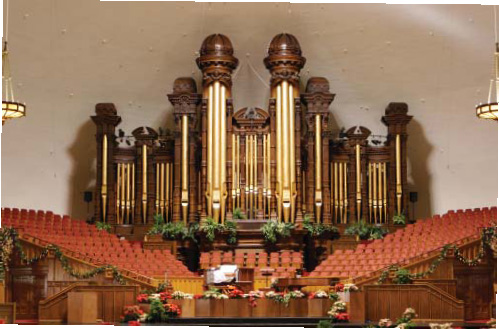
The present-day organ has 11,623 pipes made of wood, zinc, and alloys of tin and lead. The pipes are arranged into 147 voices and 206 ranks. The longest pipe has a speaking length of 32 feet, and the shortest pipe has a speaking length of 3/
At the time of the reconstruction, the console which was being replaced was described as “junk” by the company representative doing the rebuilding. This aroused the ire of a Deseret Evening News reader who wrote a most vigorous protest at such desecration of a well-remembered instrument. The letter was concluded with: “Junk? the scrap heap? ‘Not for a moment.’ The place for this historic relic, pedal box and all, is in the Deseret museum, with a placard giving the names of the noted executants who have made it a happy medium of expressing the highest ranges of musical thought, to thousands of appreciative readers.”[19]
Other changes have been made in the Tabernacle organ, and in 1932 the position of the console was changed along with the remodeling of the choir loft. Additions were also made to the organ although its exterior shape was not altered.
The public and all tourists in Salt Lake City are invited to daily organ recitals in the Tabernacle, except on Sunday. The author attended one on Tuesday, August 12, 1947. There were at least three thousand persons in attendance. Thus does the fame of the Mormon Tabernacle and its organ spread.
Notes
[1] “Joseph H. Ridges Is Called Home,” Deseret Evening News, March 9, 1914.
[2] Journal History, October 11, 1857.
[3] “Joseph H. Ridges Is Called Home,” Deseret Evening News, March 9, 1914.
[4] Levi Edgar Young, The Great Mormon Tabernacle with its World-Famed Organ and Choir (Salt Lake City: Bureau of Information, 1917), 17.
[5] Levi Edgar Young, The Great Mormon Tabernacle, 17.
[6] “Joseph H. Ridges Is Called Home,” Deseret Evening News, March 9, 1914.
[7] Guy La Coste, “The Great Organ,” Goodwin’s Weekly, April 8, 1916, 4.
[8] “Joseph H. Ridges Is Called Home,” Deseret Evening News, March 9, 1914.
[9] Truman O. Angell, “Journal.”
[10] “The Thirty-Seventh Semi-annual Conference,” Salt Lake Daily Telegraph, October 8, 1867.
[11] “The New Organ,” Deseret Evening News, July 3, 1869.
[12] Journal History, August 21, 1869.
[13] “Utah News,” Millennial Star, April 1, 1889, 206.
[14] Quoted in Levi Edgar Young, The Great Mormon Tabernacle, 19.
[15] La Coste, “The Great Organ,”4.
[16] Improvement Era, June 1901, 637.
[17] La Coste, “The Great Organ,”4.
[18] John H. McClellan, personal interview.
[19] “A Suggestion Regarding the Discarded Tabernacle Organ Console,” Deseret Evening News, May 8, 1915.
